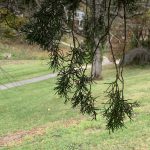
The branches dropping from the tree
The weather felt about 500F – 600F, with wind speeds that felt to be about 5 mph. It was cloudy and gloom, and it looked like it could have rained. I decided to observe one of the threes that was South of my sit spot. It has a trunk that looks to be about 40-50cm in diameter, and the bark has horizontal lines like something starches it. The bark also has some bark strand sticking out probably from organisms messing with the bark.
The branches on the tree were dropping downwards off of the trees, some were so far down that they were reaching the grass that was below the
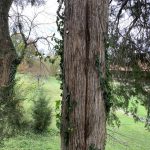
The vine growing on the trees bark
tree. The tree had needle like leaves, and some of the leaves were growing what looks like light blue egg-shaped berries, or seeds. The branches appear to be growing adjacent of each other they also spread out in pairs. For the most part the leaves are green, but some are starting to tur a brownish orangish color. The little branches where the leaves are growing have a weird texture, it looks like there are scales lapping over one another. I also found some berries that are turning black.

The view of the tree from the bottom looking up
The tree doesn’t interact with many organisms. It is surrounded by grasses and little shrubs that are growing by the roots. There is also a vine that is growing on the lower side of the trunk. I think this is an altruistic relationship because the wine does not seem to be hurting the tree. Also have heard and seen a bird who is using the tree as the home, which gives the bird protection. There are also so nubs on the tree where it looks like branches once grew and they were either cut off or broke naturally. The leaves have the similar pattern as the ranches stem off. They are on average about 1-2 inches in length and area darkish green color.
Natural History
The eastern redcedar juniper, scientifically known as Juniperus Virginiana, is a shrub
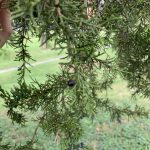
The berries/seeds growing on the tree
like tree on the easter coast of the United States. Eastern red cedar commonly occurs with shortleaf pine, Virginia pine, northern red oak, white oak, black oak, blackjack oak, hickories, and black walnut trees. When redcedar is dominate there is not much species diversity, and urea strands of red cedar occur in dry uplands, abandoned farmlands primarily, and some other hardwood species occur on the sites. Eastern redcedar has a “thing, fibrous bark” that can be anywhere from .3-.64 inches thick.
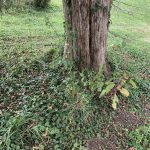
Shrubs, grasses, and weeds growing by the tree.
Leaves are born on seedling and new twigs or on mature branches where the leaves have overlapping scale-like leaves that are in opposite pairs. They usually have a shallow fibrous root system, which can penetrate 25 feet down and they may grow 20 feet on lateral roots. Easter redcedar seedlings penetrate taproots and can later develop a lateral root system. First year seedlings start to develop a long fibrous root system, usually at the expense of top growth, and when the seedling have enough soil they grow deep, but in rocky environment they are very fibrous and will spread widely. The tree is born in a small fleshy berry like cone, with 1-4 seeds per cone, and can range anywhere form.12-.33 inches in length.
Eastern redcedar can only reproduce by seed, and naturally there is not asexual
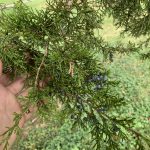
You can see the scale like texture on the leaves
reproduction so there needs to be a male and female in order to for seeds to be produced. Reproduction is influenced by tree size and site characteristics. Male trees tend to be taller and have a greater trunk diameter compared to females, which could help the success of pollen spreading. They spread their pollen through the use of wind, and seeds are spreader through birds and small animal feces, after the seeds have passed through the digestive track. Since they are available in the winter when food is scarce, birds will eat them more often and spread more seeds. Trees begin to germinate the first or second spring after the seeds are dispersed. A delayed germination can be caused. By embryo being dormant, or an impermeable seed coat.
References Cited
Anderson, Michelle D. 2003. Juniperus virginiana. In: Fire Effects Information System, [Online]. U.S. Department of Agriculture, Forest Service, Rocky Mountain Research Station, Fire Sciences Laboratory (Producer). Available: https://www.fs.fed.us/database/feis/plants/tree/junvir/all.html [2020, October 31].

Leave A Comment
You must be logged in to post a comment.